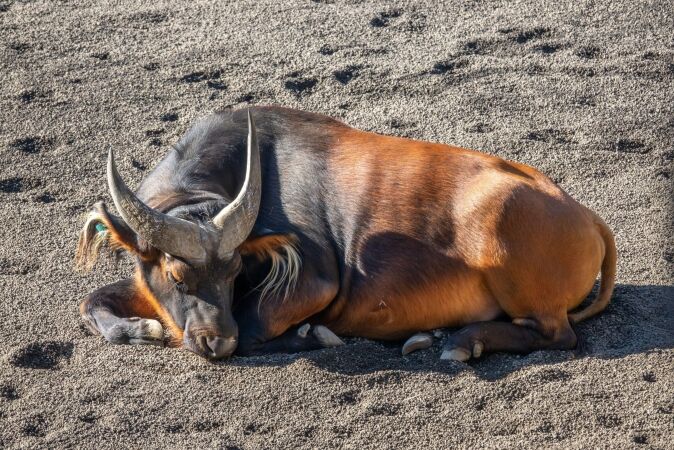

The African forest buffalo is known by a magnitude of names, including the Red buffalo, the Congo buffalo, and the dwarf buffalo. The smallest subspecies of the African buffalo, this buffalo inhabits rainforests in west and central Africa, near the equator.
The African forest buffalo is a social animal, with herds of 3-30 animals common. Herds usually consist of one or two bulls, adult females, along with their offspring. The gestation period for the forest buffalo is 300-346 days, with one or two calves being born.
They thrive in habitats inclusive of marshes, rainforests, and grassy savannas, with their diet consisting of grasses and other plants that grow on the savanna, as well as reeds and semi-aquatic plants.
In terms of predators, there aren’t too many that will take up a full-grown buffalo, except the cold-blooded Nile crocodile. Leopards, spotted hyenas and lions are opportunistic hunters though, and will prey on juvenile buffalo and calves, as well as the old and infirm of the herd.
The International Union for the Conservation of Nature has listed the forest buffalo’s status as near threatened, with habitat loss, disease, and climate change being contributing factors.
Name:
Syncerus caffer nanus
Male Weight:
584-705 pounds
Male Shoulder Height:
39-51 inches
Range:
Central and West Africa
Gestation Period:
300-346 days
Life span:
No information available
The Forest Buffalo is a resilient and elusive creature.
The forest buffalo is a smaller specimen than the Cape buffalo and adult males can weigh just over 700 pounds and stand around 39-51 inches at the shoulder. They have a distinctive cattle-like appearance but are not as large, with a hump on their backs, broad chests, and muscular legs. Both males and females of the species have horns, but they are shorter than those of the other subspecies and tend to curve upwards, making an almost “U” shape. They have a reddish-brown coat.
Buffalo hunting in Africa is usually undertaken by tracking and utilizing the walk-and-stalk technique. Stalking these dangerous game hunting species in the middle of an African rainforest has all the elements of an exceptional hunting adventure!
Hunting the forest buffalo on a dangerous game hunting safari is sure to be an exciting hunting adventure! With fewer animals in the herd than when targeting the Cape buffalo, extra care can be taken to ensure that a prize hunting trophy is selected.
As with all dangerous game hunting species targeted in Africa, a buffalo hunting safari requires a minimum of a .375 caliber shooting a 300-grain bullet. Other popular options include a 416 Rugby, 404 Jeffery, 458 WM, or Lott. Double rifles such as the 470NE, 500NE, and up are preferred, especially when in close quarters with the forest buffalo.
Search from our range of Hunts across various popular destinations in Africa.
Find A Hunt